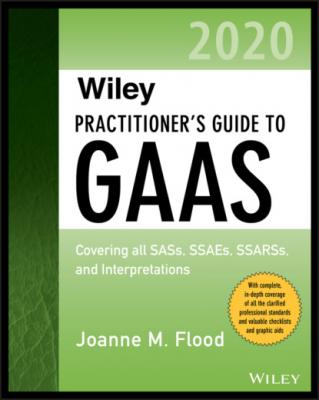Wiley Practitioner's Guide to GAAS 2020. Joanne M. Flood
Читать онлайн.| Название | Wiley Practitioner's Guide to GAAS 2020 |
|---|---|
| Автор произведения | Joanne M. Flood |
| Жанр | Бухучет, налогообложение, аудит |
| Серия | |
| Издательство | Бухучет, налогообложение, аудит |
| Год выпуска | 0 |
| isbn | 9781119596035 |
Key elements of the understanding obtained regarding each of the aspects of the entity and its environment, including each of the five components of internal control, to assess the risks of material misstatement of the financial statements, the sources of information from which the understanding was obtained, and the risk assessment procedures.
The risks identified as significant risks.
The assessment of the risks of material misstatement both at the financial statement level and at the relevant assertion level and the basis for the assessment.
(AU-C 315.33)
Examples of Matters to Consider When Obtaining an Understanding of the Entity and Its Environment
The extent of the auditor’s planning depends on the nature of the client and the experience of the auditor with that client. For example, planning for the audit of a new client is more extensive than planning for the audit of an existing client. When planning an audit, the auditor should consider the following:
The economy
The client’s industry
The client’s business
Firm requirements
These factors are in Appendix A of AU-C 315.A156 and are discussed next. All factors are not appropriate for every audit. The size and complexity of the client determine which factors are relevant.
The Economy
There are certain economic conditions that significantly influence the industry and the business of the client. The auditor should be aware of these conditions and should consider them when planning the audit. Some economic factors that might affect client operations and, therefore, should be considered in planning an audit include:
1 Interest rates and availability of financing
2 Unemployment rates
3 Money supply
4 Foreign currency exchange rates and contracts
5 Tariff trade restrictions
6 Government regulations and legislation
7 Overall business conditions—depression, recession, inflation
The Client’s Industry
When planning the audit, the auditor should be aware of conditions in the client’s industry. Factors to consider include the following:
1 Growth and financial results of the industry; possible sources of this information are:Industry trade association literaturePublications issued by agencies such as Moody’s, Standard & Poor’s, and Robert Morris AssociatesGovernment publications issued by the Government Printing Office, Washington, D.C.
2 Cyclical and seasonal nature of the industry
3 Product technology
4 Supply availability and cost
5 Is the industry labor intensive or capital intensive?
6 Industry labor conditions:Is the industry unionized?Has the industry recently experienced a strike?
7 Accounting principles and industry accounting practices; this information may be obtained from firm members with clients in the same industry and the American Institute of Certified Public Accountants (AICPA) Industry Audit and Accounting Guides.
8 Industry price patterns and consumer reactions to price changes
9 Regulatory environment
10 Taxation:Number of bankruptcies during the past yearNumber of new companies organized during the current year
In addition to the information the auditor obtains about the client’s industry from industry- related publications, he or she may obtain industry information from bankers, client management, auditors with clients in the same industry, and general business publications, such as the Wall Street Journal, Bloomberg Businessweek, Forbes, and Fortune.
The Client’s Business: New Client
When planning the audit, the auditor should have a knowledge of the client’s operations. For a new client, the primary sources of information are discussions with the predecessor auditor and inquiries of client management.
For a new client, the auditor should learn about the client and plan the audit by doing the following:
1 Communicate with predecessor auditor.
2 Visit client’s administrative office and major facilities.
3 Review year-end financial statements of prior year and interim financial statements of current and prior year.
4 Review auditor’s report on prior year’s financial statements:Was there a scope limitation?Were certain matters emphasized?Did the auditor disclaim an opinion or issue an adverse opinion?Were there other modifications of the auditor’s standard report?
5 Review prior year’s income tax returns.
6 Obtain the results of the most recent income tax examination.
7 Review reports issued to agencies, such as the following:Securities and Exchange Commission (SEC)Federal Housing Administration, Small Business Administration, and Department of LaborCredit agencies and banks
Visit to Administrative Office
During a visit to the client’s administrative office, the auditor should do the following:
1 Meet with in-house legal counsel and inquire about:LitigationCompliance with laws and regulationsKnowledge of fraud or suspected fraudWarrantiesPostsales obligationsArrangements, such as joint ventures, with business partnersThe meaning of contract terms
2 Meet with financial and administrative officers and obtain or determine the following:The functions of each executiveThe executive responsible for the auditThe existence of an internal audit functionOrganization chartsLocations and relative importance of all offices, showrooms, warehouses, and factoriesCorporate manuals or memoranda that provide information about the following:Nature and description of the entity’s productsProduction and distribution methodsInternal controlGeneral ledger chart of accountsMethods of financing the entity’s operationsSchedule of long-term debtNames of banks and account executive at each bank; for each bank, determine the following:Outstanding indebtedness and terms of paymentLines of creditOther banking servicesFor nonpublic companies, a schedule of stockholders with the following information:NamesAddressesCertificate numbersNumber of shares heldShareholder function in the businessPurchase terms:Terms of paymentAre letters of credit used for foreign purchases?Sales terms:Terms of paymentAre letters of credit used for foreign sales?Changes in the entity’s marketing strategies, sales trends, or contractual arrangements with its customersThe existence of related-party transactions such as the following:Purchases and salesLoansReceiving or providing services, such as management, legal, and administrativeInformation systems:System changesSystemic control failuresOther information systems-related risksSchedule of all affiliates and nonconsolidated subsidiariesCustomers and suppliers on whom the entity is economically dependentMost recent trial balanceGeneral ledger and books of original entry:Are accounting records up to date?What is the quality of accounting records?Extent of client responsibility, including the involvement of the internal audit function, for preparation of the following:Trial balanceSchedulesAdjustments
